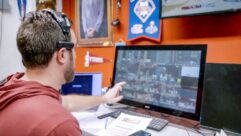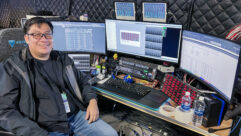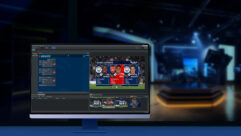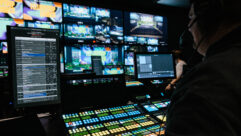
Annapolis Junction, Maryland
— Great athletes, phenomenal coaches, and a few strands of fiber optics are keeping the University of Kentucky in the game.
As one of 14 elite colleges participating in the newly formed Southeastern Conference (SEC) Network, the university recently underwent a sports facility upgrade that included
fiber optic communications in order to originate more content for the ESPN network.

“There’s a lot of information passing through those fibers,” says Tim Mays, SEC Network Producer/Director for the University of Kentucky, Lexington, referring to a new portable audio/video booth kit that uses FiberPlex
and
optical audio transport systems for sending and receiving 24 channels of audio; eight channels of intercom; and four streams of video down one fiber pair.
The multiplexer, known as a wavelength division multiplexer, was critical for relaying additional channels of audio and intercommunications between the university’s main control room and sporting events held in fields and on courts across campus. FiberPlex’s WDM-16 multiplexes 16 channels onto optical cable by transmitting each channel at different lightwaves, yielding data rates ranging from 155 megabits to 3 gigabits (or more) per channel for a possible aggregate data rate of 48A Gbps on a fiber pair.
“We’re seeing a slow migration from triax cable to fiber in the field, especially at this level where there’s more demand for original material,” says Jason Kress, Project Manager for Take One, an AV systems integrator in Hendersonville, Tennessee, who provided University of Kentucky with the new portable booth kit and optical multiplexer.
SEC schools are producing more content locally as a result of the new SEC Network launched in August by ESPN and the conference to bring college basketball, baseball, football and soccer to a wider viewership. SEC games are now showing on the SEC Network as well as ESPN’s family of networks.
In order to provide 24/7 coverage of the nation’s most elite conference, ESPN established guidelines for SEC colleges contributing live action sporting coverage and content.
“If we were going to achieve the look and feel of ESPN, we needed to have at least two announcer positions, preferably three, and sometimes a sideline reporter. We needed to have monitors in front of them so they could see the replays, and all that had to be transported back to the control room along with a multitude of other feeds. And, it had to be done in a fashion that is efficient and makes them sound good, and certainly not like it’s coming out of a transistor radio,” explains Mays.
With distance, bandwidth and cost issues limiting the practical use of copper triax coax cable for high-bandwidth multimedia use, the university implemented fiber optic multiplexing as a practical intra-campus network solution.
For many of the links between the control room and sports venues on campus, Mays was able to add the FiberPlex
directly onto existing single-mode fiber optic runs that had been put in place for data communications as part of an IT install years ago.
“Universities are actually good candidates for wavelength division multiplexing because they were one of the first to adopt fiber optics for data communications years ago. To get video and audio over those preexisting fibers, all they have to do is add on a pair of multiplexers (versus trenching and/or directional boring to add more fiber). The multiplexers will simultaneously split and combine multiple high bandwidth systems, bi-directionally, onto those same fibers,” explains Kyle Rosenbloom, National Sales Director forA
which makes optical converters and multiplexers for AV, medical, industrial and other applications.
Fiber optic communications is a cornerstone technology for ESPN, which transports all collegial sporting coverage and content over a fiber backbone from SEC venues to its broadcast center in Charlotte. The multimedia sports entertainment giant is also working with Google Fiber to carry the SEC Network over the last mile to viewers in those select markets that have fiber connectivity.
ESPN and SEC Network expect to carry more than 1,000 SEC football, basketball, baseball and other sporting events annually, getting into 60 million+ homes nationwide.









